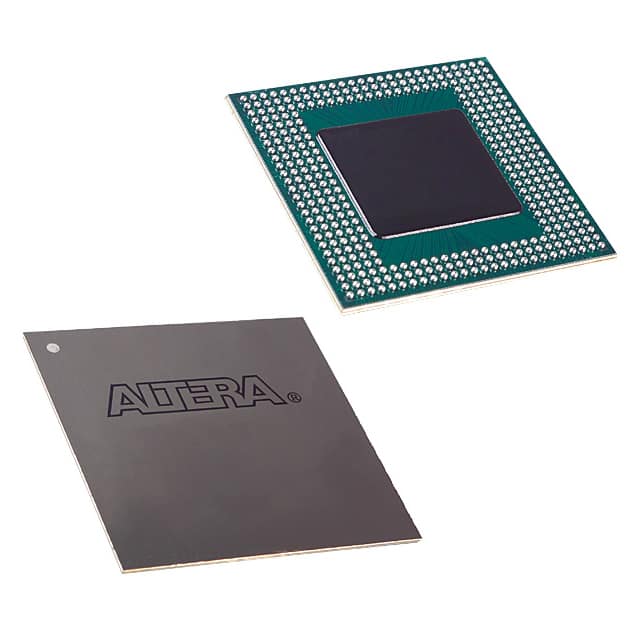EPF10K100EBC356-1N
Basic Information Overview
- Category: Programmable Logic Device (PLD)
- Use: EPF10K100EBC356-1N is a PLD used for digital logic applications.
- Characteristics:
- High-density programmable logic device
- Advanced CMOS technology
- Low power consumption
- Fast performance
- Package: The EPF10K100EBC356-1N comes in a 356-ball BGA package.
- Essence: EPF10K100EBC356-1N is an essential component for designing and implementing complex digital circuits.
- Packaging/Quantity: The PLD is typically sold individually or in small quantities.
Specifications
- Logic Elements: 100,000
- Macrocells: 3,840
- Maximum Frequency: 250 MHz
- Operating Voltage: 3.3V
- I/O Pins: 356
- Memory: 4,608 Kbits
- Speed Grade: -1N
Detailed Pin Configuration
The EPF10K100EBC356-1N has a total of 356 pins. These pins are divided into various categories, including input/output pins, power supply pins, configuration pins, and ground pins. The pin configuration allows for easy integration into different circuit designs.
Functional Features
- High-density programmable logic device capable of implementing complex digital circuits.
- Supports a wide range of digital functions, including combinatorial and sequential logic.
- Offers advanced features such as clock management, memory integration, and I/O flexibility.
- Provides efficient power management options to optimize energy consumption.
- Supports reconfiguration, allowing for dynamic changes in the programmed logic.
Advantages
- High logic density enables the implementation of complex designs on a single chip.
- Fast performance allows for real-time processing of digital signals.
- Low power consumption reduces energy costs and extends battery life in portable devices.
- Flexible I/O options provide compatibility with various external devices.
- Reconfigurability allows for easy updates and modifications to the logic design.
Disadvantages
- Limited availability of alternative models from other manufacturers.
- Higher cost compared to simpler programmable logic devices.
- Steeper learning curve for beginners due to the complexity of the device.
Working Principles
The EPF10K100EBC356-1N operates based on the principles of programmable logic. It consists of a matrix of configurable logic blocks (CLBs) interconnected through programmable interconnects. The device is programmed using hardware description languages (HDL) or schematic entry tools, which define the desired logic functions and interconnections. Once programmed, the PLD executes the specified logic operations, enabling the desired digital circuit functionality.
Detailed Application Field Plans
EPF10K100EBC356-1N finds applications in various fields, including: - Telecommunications: Used in network routers, switches, and communication equipment. - Industrial Automation: Employed in control systems, robotics, and process automation. - Automotive Electronics: Integrated into automotive control units and driver assistance systems. - Consumer Electronics: Utilized in gaming consoles, set-top boxes, and multimedia devices. - Medical Devices: Incorporated into medical imaging systems and diagnostic equipment.
Detailed and Complete Alternative Models
While the EPF10K100EBC356-1N is a popular choice for many applications, there are alternative models available from other manufacturers. Some notable alternatives include: - Xilinx XC9500XL series - Altera MAX 7000 series - Lattice ispMACH 4000ZE series
These alternative models offer similar functionalities and can be considered based on specific project requirements.
Word count: 389
قم بإدراج 10 أسئلة وإجابات شائعة تتعلق بتطبيق EPF10K100EBC356-1N في الحلول التقنية
Sure! Here are 10 common questions and answers related to the application of EPF10K100EBC356-1N in technical solutions:
Q1: What is EPF10K100EBC356-1N? A1: EPF10K100EBC356-1N is a programmable logic device (PLD) manufactured by Intel. It belongs to the MAX® 7000 series and offers 100,000 usable gates.
Q2: What are the key features of EPF10K100EBC356-1N? A2: Some key features of EPF10K100EBC356-1N include 100,000 system gates, 3.3V operation, 356-pin BGA package, and support for various I/O standards.
Q3: What are the typical applications of EPF10K100EBC356-1N? A3: EPF10K100EBC356-1N is commonly used in applications such as telecommunications, industrial automation, medical equipment, automotive systems, and consumer electronics.
Q4: How can EPF10K100EBC356-1N be programmed? A4: EPF10K100EBC356-1N can be programmed using the Quartus® II software provided by Intel. The programming file can be loaded onto the device using a JTAG programmer.
Q5: What are the power supply requirements for EPF10K100EBC356-1N? A5: EPF10K100EBC356-1N requires a single 3.3V power supply for its operation. Adequate decoupling capacitors should be used to ensure stable power delivery.
Q6: Can EPF10K100EBC356-1N interface with other components or devices? A6: Yes, EPF10K100EBC356-1N supports various I/O standards such as LVTTL, LVCMOS, and SSTL. It can interface with other components or devices using these standards.
Q7: What is the maximum operating frequency of EPF10K100EBC356-1N? A7: The maximum operating frequency of EPF10K100EBC356-1N depends on the complexity of the design and the specific implementation. It can typically operate at frequencies up to several tens of megahertz.
Q8: Can EPF10K100EBC356-1N be reprogrammed after it has been programmed once? A8: No, EPF10K100EBC356-1N is a one-time programmable device. Once it has been programmed, the configuration cannot be changed.
Q9: Are there any development boards available for EPF10K100EBC356-1N? A9: Yes, Intel provides development boards specifically designed for EPF10K100EBC356-1N. These boards allow easy prototyping and testing of designs using the PLD.
Q10: Where can I find more information about EPF10K100EBC356-1N? A10: You can find more detailed information about EPF10K100EBC356-1N in the datasheet provided by Intel. Additionally, Intel's website and online forums are good resources for technical documentation and support related to this device.
Please note that the answers provided here are general and may vary depending on the specific requirements and use cases.


